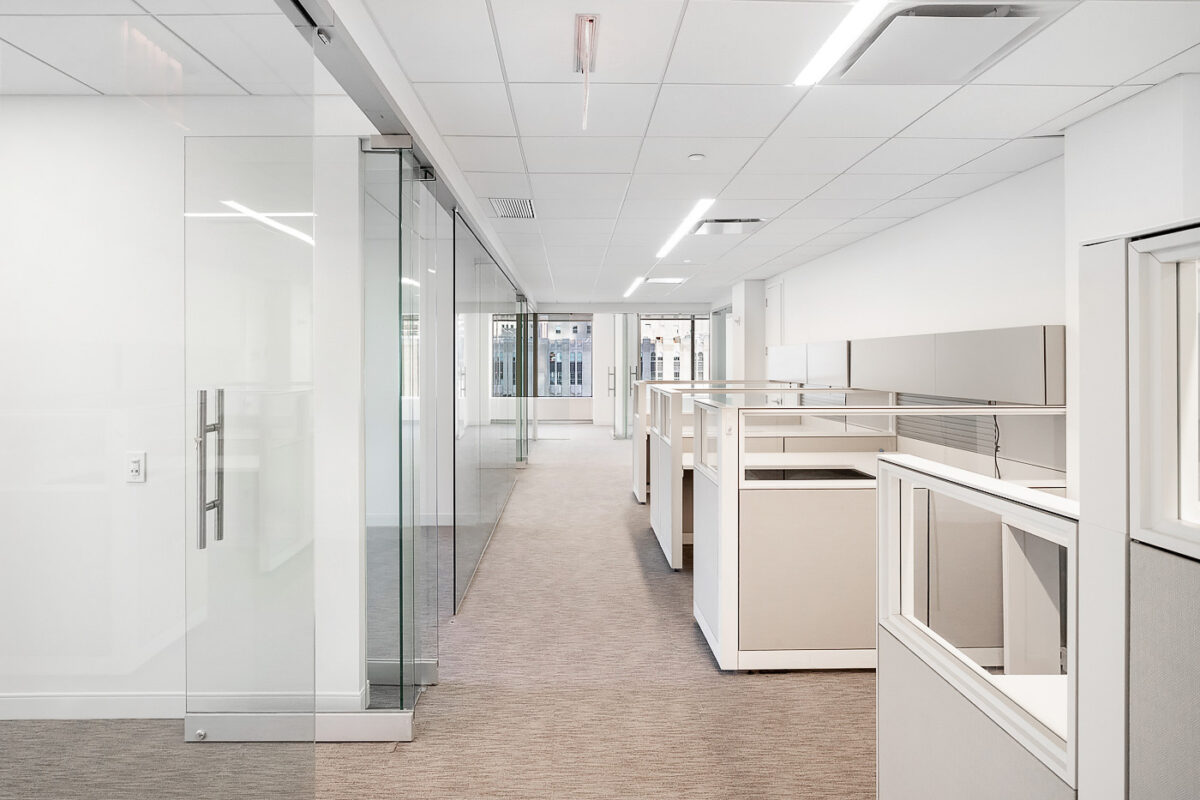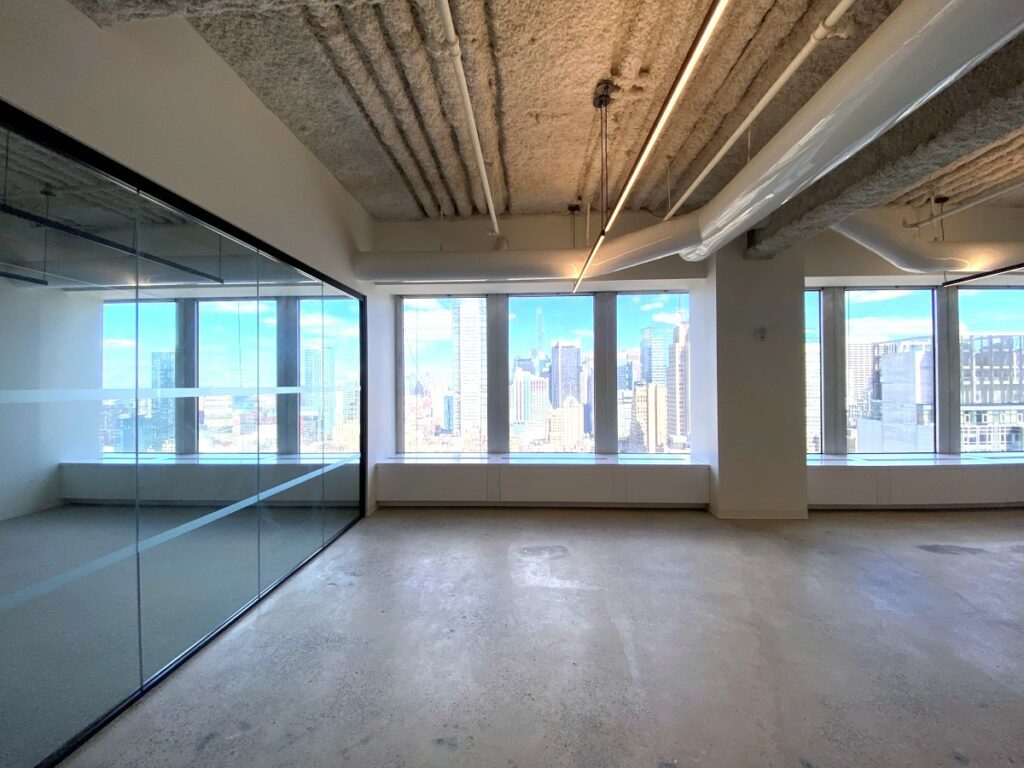
How Much Space Do I Actually Need?
Many people pick office size based only on current employees. But here’s where planning ahead matters:
- You should count your current team and project growth (interns, new hires) for the next 1–3 years. Just in case your team grows, you’ll need a bigger space then.
- Think about how many private offices, meeting rooms, and open desks you’ll need. Don’t forget space for visitors and storage.
- Be clear on usable vs. rentable square feet. Usable is what your team walks into; rentable includes shared space (lobbies, hallways). You’ll pay for both, but use only one.
At Unique Workspaces, we often guide tenants who thought they needed 2,000 sf but ended up using closer to 2,500 sf once they included storage, client rooms, and collaboration zones. This real-life example teaches us to calculate the total area beforehand.
Where Should My Office Be Located?
Location isn’t just about prestige. It can affect commute, cost, team morale, and even client access.
- Ask yourself which neighborhoods make sense for your business? Midtown, FiDi, Chelsea, and SoHo all have different vibes and price points. So pick one that aligns with your work.
- Is transit accessible (subway, bus, ferry)? If your team or clients rely on public transport, that’s a huge plus. Because no one likes to be at work changing 10 vehicles.
- Nearby amenities like cafés, lunch spots matter more than you think. A walkable neighborhood boosts satisfaction and helps your employee re-focus on their work.
- For certain businesses (legal, medical, wellness), being close to industry nodes or related services might benefit you.
Unique Workspaces regularly sees clients shift priorities to transit-oriented or amenity-rich areas because those subtle differences compound over time.
What Kind of Building Should I Pick?
The building itself can make or break your workspace experience. Don’t ignore these factors:
- You must check the building category before signing the lease. Ask the landlord if the building is Class A, B, or C. Class A is more premium, typically offers newer systems, better finishes, and more amenities. But the rent is also higher.
- What are the building’s common areas like? Lobbies, elevators, security, and maintenance matter. They reflect what employees and clients see daily.
- Questions around access: Do you have after-hours access? Loading docks or freight access? Parking options? Are there dedicated visitor zones?
- Building infrastructure: fast internet connectivity, backup power, HVAC quality, all essential for smooth operations.
What Lease Terms & Hidden Costs Should I Know?
Lease isn’t just base rent. Many offices have additional costs and obligations.
- Before signing the lease, ask what’s included in the lease. Utilities, cleaning, property taxes, insurance, and CAM (common area maintenance) charges are important facilities for your office to run smoothly.
- The second question should be focused on the lease’s lifespan. Short leases offer flexibility, which is beneficial for small companies and startups. On the other hand, longer leases often allow negotiation of better rates or improvements.
- What are escalation clauses? Sometimes rent increases annually with inflation or other benchmarks. If not informed beforehand, you’ll get a shocking increase in your rent fee, so you need to know how steep those may be.
- Build-outs and improvements: If you need to customize (walls, tech, finish), is there a Tenant Improvement Allowance? Who pays for permits and contractor work?

What Amenities & Services Will You Get?
Amenities are not just optional facilities. Your company’s image depends upon it. They also affect recruiting, culture, and productivity.
- Depending on your company and work type, you’ll need On-site amenities like conference rooms, shared lounge spaces, cafes, fitness, or bike storage.
- Nowadays, no work can be done properly without technology perks. Every team needs a fast, resilient internet, backup connectivity, and security systems.
- Building sustainability in your office will help you achieve: energy-efficient lighting, ventilation, and green certifications. These matter for cost savings and branding.
What About Timing & Move-In Logistics?
Even if you love a space, when and how you move in can derail the process.
- How long will build-out or renovations take? Sometimes modifications push move-in dates out months.
- Watch out for permits and inspections. You must check if the city approves what you plan? Do you need architectural drawings?
- Flexibility is another issue you must acknowledge. What happens if you need to scale up or down? Can you sublet, expand, or exit early? These questions help you get flexibility and scalability when you need it in the future.
Who's Supporting You Through the Lease Process?
It helps to have a knowledgeable partner.
- If you have a commercial real estate broker or consultant, they should help you negotiate, spot pitfalls, and represent your interests. So ask yourself if you have a knowledgeable partner in this field or not.
- Understand the landlord’s reputation, responsiveness, maintenance, fairness. Visit other properties they manage if you can. This will help you get a better idea of him.
Find the Right NYC Office Lease: Key Questions Every Business Should Ask
Asking the right question makes leasing an office in NYC much easier. Ask about office size and neighborhood to building features, cost structure, and flexibility. This clarity up front saves you trouble later.
At Unique Workspaces, we guide you through these questions. We help you weigh what matters most for your business. So you can negotiate smart lease terms and ultimately secure a space that fits growth, culture, and budget. Need help getting started? Contact us for a personalized consultation, and let’s find your next NYC workspace with confidence.
FAQs: Common Questions NYC Office-Seekers Ask
Q: How long is a typical lease term in NYC?
Many businesses go for 3-5 years, but Class A leases often run 5–10 years. If you want shorter, expect fewer tenant build-out perks.
Q: What is the difference between usable and rentable square feet?
Usable is the space you can use directly (offices, meeting rooms). Rentable includes usable + shared spaces you pay for (hallways, lobbies).
Q: How much does office space cost in neighborhoods like Midtown or FiDi?
Rent can vary widely: prime Class A space often commands high rents (Midtown, FiDi), while neighborhoods a bit further or in older buildings may offer more reasonable rates. Always check the latest market reports or ask your broker.
Q: Can I negotiate the rent or lease terms?
Yes. Many landlords expect it. You can ask for Tenant Improvement Allowances, free rent months, escalation caps, and flexible renewal options.
Q: What happens if I outgrow my space mid-lease?
Check if your lease allows expansion in the same building, subletting unused space, or use of shared coworking space temporarily. Flexibility clauses are super useful.